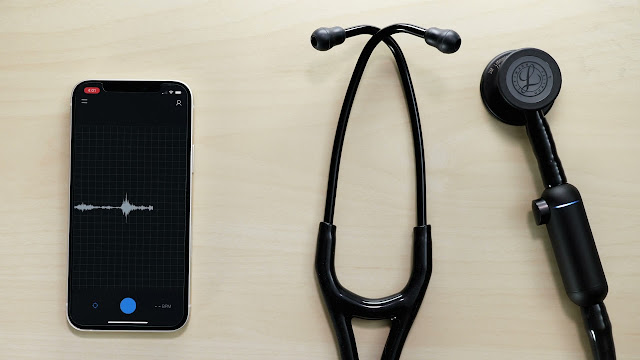The Future of Medical Diagnosis is Here
 |
| Digital Stethoscope: |
What is a Digital Stethoscope?
A digital stethoscope is an electronic medical device that digitally converts,
records, and transmits heart and lung sounds. It works similarly to a
traditional acoustic stethoscope but utilizes a sensor in the chest piece to
convert acoustic sounds into digital signals. These digital signals are then
processed by a small computer within the handle of the stethoscope. The sounds
can then be heard through headphones or speakers or stored on a computer for
later playback and analysis.
Some key components of a Digital
Stethoscope include a piezoelectric sensor or microphone in the chest
piece, an analog-to-digital converter, digital signal processor, memory,
battery, and headphones or speakers. The chest piece collects the sounds while
the electronics in the handle amplify, filter, and transmit the signals. Digital
stethoscopes connect to apps, computers, and networks via wired USB connections
or wireless Bluetooth or Wi-Fi allowing for a more advanced diagnosis.
How Does a Digital Stethoscope Work?
When placed against the chest, the sensor in the diaphragm of the chest piece
picks up heart and lung sounds in acoustic format. The sensor converts these
sounds into electrical signals that are then amplified by an integrated
circuit. The amplified analog signals are converted to digital format by an
analog-to-digital converter. The digital signals are enhanced through noise
cancellation and filtering techniques by a digital signal processor.
The processed digital sounds can then be listened to in real-time through
headphones, recorded on the device's internal memory or uploaded to a computer.
Some advanced models also allow the sounds to be wirelessly transmitted via
Bluetooth to smartphones for access to diagnosis apps and sharing findings with
remote colleagues over networks. The recorded digital sounds remain unaffected
by external noises and provide better clarity and fidelity compared to
traditional acoustic stethoscopes.
Advantages of Digital Stethoscopes
Wider Frequency Range
Traditional stethoscopes can only pick up sound frequencies between 100-2000 Hz
which misses some important higher and lower frequency sounds. Digital
stethoscopes have a much wider frequency range of 20-8000 Hz allowing doctors
to hear subtle sounds that may indicate pathology. This improves diagnostic
accuracy.
Amplification and Noise Cancellation
Digital stethoscopes digitally amplify weak heart and lung sounds for better
auscultation. Integrated noise cancellation filters out ambient sounds like
speech, machines etc for clearer listening. This is particularly useful in busy
clinical settings.
Recording and Playback Capabilities
Digital stethoscopes can record heart and lung sounds internally or on external
devices like smartphones. Recorded sounds can be replayed, annotated, shared
and compared over time to analyze changes. This aids longitudinal monitoring of
patients. Recordings can also be used for medical education and telemedicine
consults.
Sharing Findings with Colleagues
Digital recordings captured on smartphones can be easily shared via email or
cloud upload with consulting physicians located remotely. This facilitates
second opinions and consults especially useful in telemedicine. Recordings are
also useful for discussions during rounds and case presentations.
Telemidine and Remote Diagnosis
With wireless data transmission, some digital stethoscope models support
real-time auscultation over distances. This enables teleconsultations and
remote monitoring of patients in rural areas, homes, ambulances and during
transportation. It can improve access to care.
Educational Use
Digital recordings provide an objective method for training medical students
and residents. Specific recordings highlighting various abnormalities can be
replayed repeatedly for educational discussions. Some models also have
interchangeable mock samples that can mimic heart and lung sounds for
simulations.
Comfort and User-Friendly Design
Most digital stethoscopes have a lightweight ergonomic design and soft ear tips
for long term comfort compared to bulky acoustic models. Features like
touchscreen app navigation and integrated controls also make them more
user-friendly.
In summary, digital stethoscopes offer enhanced auscultation capabilities
compared to traditional acoustic models. Their improved analysis
functionalities using digital technologies support advanced diagnosis,
management, education and telemedicine. As the technology evolves further,
digital stethoscopes are poised to transform cardiac and pulmonary examination.
Get more
insights, On Digital
Stethoscope



Comments
Post a Comment